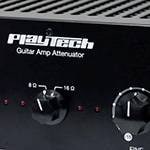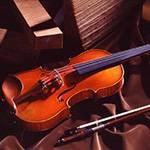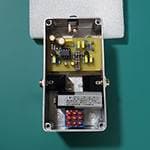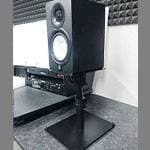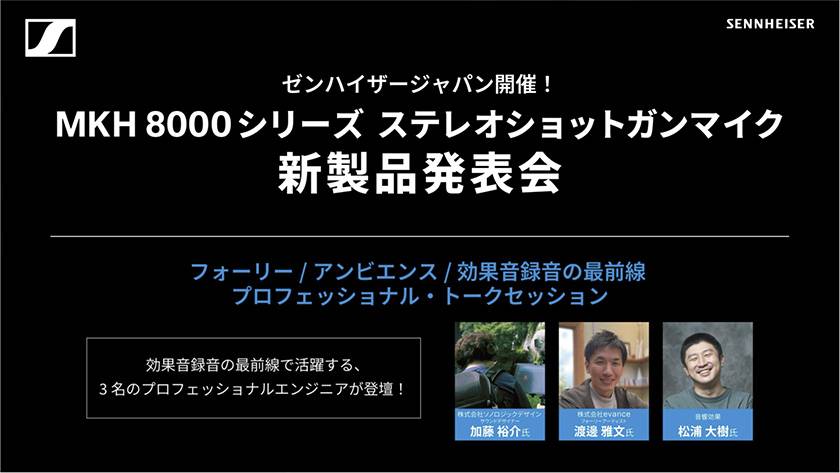
A product launch event for the new Sennheiser MKH 8000 series, the brand whose products are highly trusted for sound-effects recording and broadcasting, was held on July 29, 2025 in the immersive demo room at Nihon Kogakuin Kamata campus in Tokyo. The venue is the largest Neumann speaker demo room in Japan and was created through a collaboration between Nihon Kogakuin and Neumann, and featured displays of all models in the series and an immersive playback setup using Neumann KH 150, KH 120 II, and KH 750.

Together with the launch event, a talk was held featuring three professional engineer guest speakers who are active on the front lines of sound‑effects recording. Despite it being a midsummer day over 35 °C, there were many viewers wanting to attend. The venue was full of audience members as the new product presentation began.
RF-Type MS Microphone MKH 8018 Made Possible by Sennheiser’s Technology
The event began with a presentation by Inori-san from Sennheiser Japan, who introduced the 80-year history of Sennheiser and went on to explain the new features and the technical features of the newly added MKH 8000 series
The model name “MKH” is said to be derived from the German words for Microphone (Mikrofon), Condenser (Kondensator), and High Frequency (Hochfrequenz). The representative from Sennheiser Japan explained the advantages of the RF (radio frequency) design, such as high signal-to-noise ratio, excellent low-frequency response, superior off-axis characteristics, and compact form factor—and the audience listened attentively.
According to the explanation, the latest MKH 8000 series achieved miniaturization thanks to Sennheiser’s SMD (Surface Mount Device) technology. In 2007, three models were released: the MKH 8020 (omnidirectional), MKH 8040 (cardioid), and MKH 8050 (supercardioid). The series continued to expand, and in 2024, the bidirectional MKH 8030 was released. It seems that the launch of this bidirectional 8030 led directly to the release of the new product announced at this event.
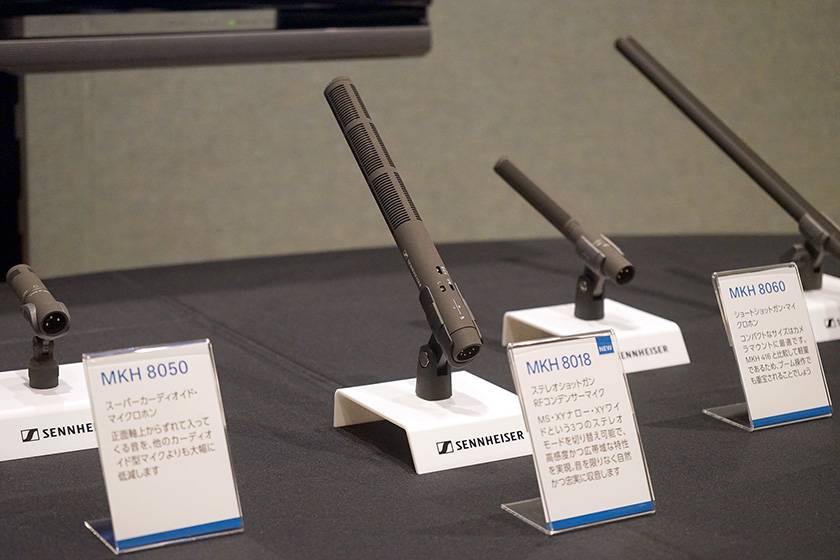
Following the explanation of the technology and history, the new MKH 8018 was finally unveiled.
The MKH 8018 is an MS stereo shotgun microphone that inherited the MKH technology. It can output not only MS signals but also stereo signals by switching modes, and its stereo width can also be switched between narrow and wide as needed. The relationship to the MS stereo shotgun microphone MKH 418-S, which was released in 2003, was also touched upon, and it was stated that the MKH 8018 is positioned as its successor and higher-end model. In terms of performance, the MKH 8018 significantly surpasses the MKH 418-S, and was described as the culmination of the MKH 8000 series.
Professional Reviews and Talk Session
In the second half of the presentation, a talk was held featuring three guest speakers who are active in sound effects recording. These three guest speakers were already longtime users of the MKH 8000 series, and it appears they had been loaned demo units of the new MKH 8018 prior to the official announcement. They shared their impressions after testing the mic in recording environments, along with concrete insights into sound recording, making for a session full of practical and informative information for the attendees.
The MKH 8018’s Superiority Lies in Its Exceptionally Quiet Side Capsule

The first guest speaker was Yusuke Kato-san, a sound designer at Sonologic Design Co., Ltd. Speaking from the perspective of a game sound designer who creates all the sound effects in a game, he introduced five key points that highlighted the MKH 8018’s excellent performance in recording both positional sources and ambient sounds, and how it compares it with previous models.
The first point he emphasized was the quietness of the side microphone. With the previous model, the MKH 418-S, Kato-san himself had encountered issues regarding the side capsule’s signal-to-noise ratio (SN), so this was the first point he tested. As a reference, an audio sample recorded in a cave environment with no sounds other than dripping water was played, and he stressed that the MKH 8018 captured the sound clearly without any noise.
Next, he introduced the lightweight and compact design of the microphone. He explained that by using an L-shaped XLR-5 pin connector cable, the MKH 8018 fits into his Rycote Cyclone Small windshield, and that when using a pistol grip, it can be carried together with a recorder inside a shoulder bag.
The third point Kato-san addressed was the ability to switch recording modes. While the MS (Mid-Side) method typically requires post-processing, the XY narrow and wide mode outputs can be used directly as stereo signals. This means users can easily perform stereo recording alongside a 2-channel recorder or a camera microphone. According to Mr. Kato, this makes the MKH 8018 a viable competitor to models such as the Neumann RSM 191 and Sanken CSS-5.
The fourth point he highlighted was the ability to capture a wide frequency range, from low to high, with high audio quality. Compared to earlier models, the MKH 8018 also offers improved sound detail. He noted that the Mid capsule can be used just like a standard shotgun mic that’s similar to the MKH 8060, and thanks to the MKH 8000 series’ gentle off-axis attenuation, it blends well with the Side capsule for a natural stereo image.
The fifth point was the fact that the Mid and Side output levels are well balanced, which Mr. Kato described as a very surprising aspect. He owns other microphones in the MKH 8000 series and has experience recording in MS and DMS formats, but with the MKH 8018, he noted that the Mid and Side volumes were already balanced without requiring fine-tuning.
Based on these features of the MKH 8018, Kato-san evaluated it as a microphone well-suited for capturing environmental sounds and positional materials from the perspective of game sound production. For environmental recordings that require spatial spread and a moderately soft mid-range, he noted that the XY wide mode is ideal. Conversely, when a solid, focused center sound is needed with just the right stereo image on the sides, the MS mode becomes preferable. He praised the microphone's flexibility and high level of expandability.
Kato-san’s explanation reflected a deep understanding of real-world use, and he effectively translated the product’s features into practical, on-site scenarios. His commentary stood out especially because it was grounded in first-hand experience, both with the previous model, MKH 418-S, and with other mics in the MKH 8000 series, as he clearly highlighted the improvements and advantages.
Sonologic Design Inc.
Sound Designer
Yusuke Kato
After working as a sound director and sound designer for mobile titles, Kato-san joined Sonologic Design. He began field recording with a small handheld recorder and now uses professional-grade recorders and microphones. In addition to M/S microphones, he favors mics capable of capturing realistic textures, such as those for Ambisonics and binaural recording.
Compact and Durable MKH 8000 Series, the MKH 8018 Handles a Wide Range of Recordings with Just One Mic
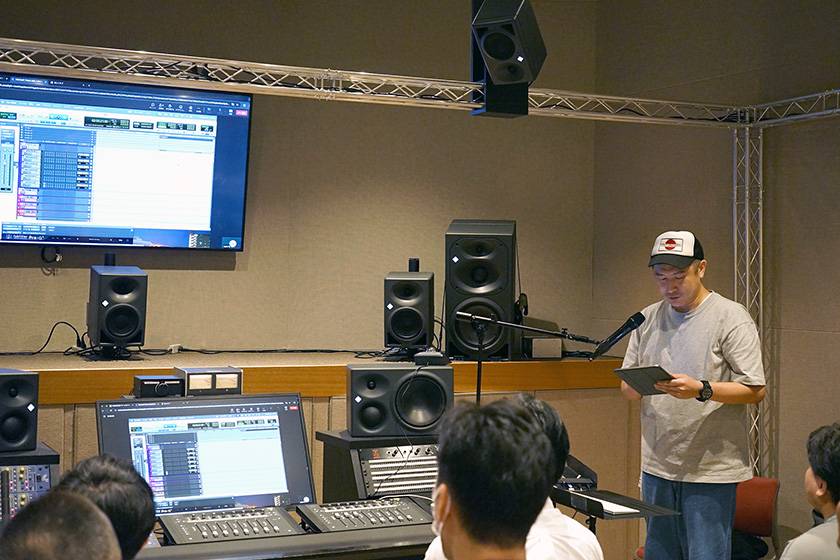
Following Kato-san, Daiki Matsuura-san, a sound effects engineer active in films, dramas, and commercials, took the stage. He presented how the MKH 8000 series is used on-site, along with actual photos and audio samples.
Matsuura-san had already adopted many of the MKH 8000 series microphones and, for multi-person foley recordings, introduced the MKH 8030 as a reinforcement mic to capture off-axis sources. This led him to experiment with DMS (Double Mid-Side) recording in field recording settings using combinations of other MKH 8000 series models.
He cited not only audio quality but also compactness and durability as key reasons for adopting the MKH 8000 series, saying that those aspects are just as important as sound quality. Several sample recordings were played, and the specific combinations of MKH 8000 series mics used were shown with accompanying photos. For example, for recording Godzilla’s roar at ZOZO Marine Stadium, he used four MKH 8020s in an omni square formation plus an MKH 8050 in the center. For recording the sound of fireworks, he used two MKH 8040s in ORTF configuration, with an MKH 8050 and MKH 8020 for the center and LFE elements, resulting in a 5.1ch recording.
These real-world examples were highly informative.
The MKH 8000 series microphones are each compact, but managing a large number of them can be challenging, which is where the demo of the new MKH 8018 came into play.
First, Matsuuura-san played an audio demonstration of recorded rain sound, where the sound from the Mid capsule was gradually blended with that from the Side capsule. This showcased the advantage of the MS stereo microphone, allowing for post-recording adjustment of the side signal level. Matsuura-san then compared MKH 8018 with the MKH 418-S, and like Kato-san, emphasized the ability of the MKH 8018 to capture exceptionally low self noise as it provided a clear advantage, especially when recording very quiet sounds.
Following this, he demonstrated comparisons between the different modes of the MKH 8018 and stereo recordings using other MKH 8000 series models. Participants were able to experience firsthand the differences in stereo spread and center channel presence through their own listening.
In conclusion, Matsuura-san highlighted that the MKH 8018 offers multiple recording modes within a single microphone and praised its compactness. He emphasized that with the right combinations and creative ideas, this microphone expands the possibilities of recording and could become a new choice for field recordists worldwide.
Sound Effects
Daiki Matsuura
After working at the sound effects company Arcabooth, he became independent in 2020. He works in sound effects for films, Netflix streaming dramas, and commercials. His main works include My Home Hero, Missing, Hakkenden, and Sayonara no Tsuzuki. He is a devoted user of the MKH 8000 series microphones for Foley and location sound recording in projects where he is responsible for sound effects. Recently, he has started doing DMS recording with these microphones.
Potential as a Microphone Housing Two Mono Capsules
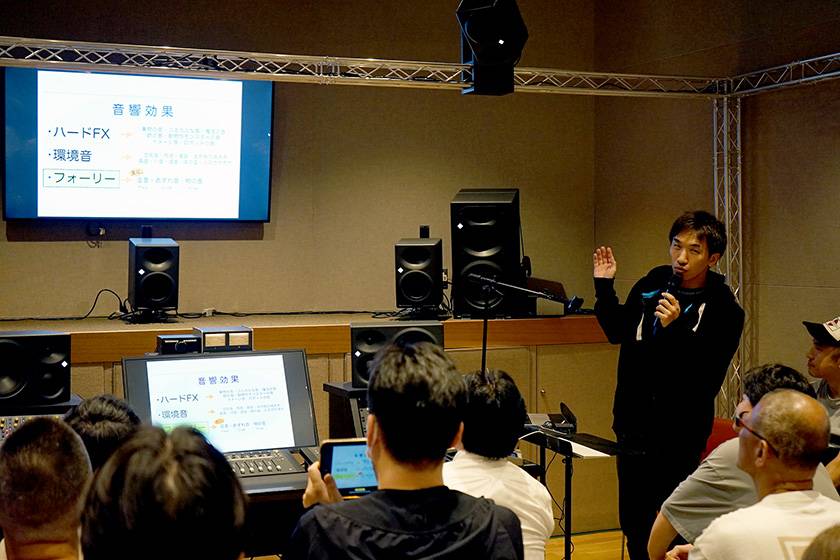
The final guest speaker was Masafumi Watanabe, a Foley artist based in Takamatsu City, Kagawa Prefecture. He is involved in sound effects production for anime, games, commercials, and more. Watanabe began by discussing the approach of using a stereo microphone for mono recording, which piqued the curiosity of the audience.
In live-action Foley production, it is common to set up an off-mic apart from the main mic to capture room ambiance and a sense of distance. However, for the anime and game Foley sounds that Watanabe frequently handles, off-mic sound often doesn’t fit and is frequently deemed as unnecessary. Yet, relying solely on the main on-mic can result in a sound that is too peaky and in need of some smoothing out. It was at this point that he arrived at the method of mixing the MS stereo mic’s side microphone as a substitute for the off-mic, creating a softer, more mellow sound. Last year, after purchasing Sennheiser’s bidirectional microphone the MKH 8030 and the shotgun microphone the MKH 8060, Watanabe-san combined them to implement this method, and that’s when he learned about the release of the MKH 8018. He lamented the timing, saying, “It would definitely be cheaper to just buy one of these,” which brought out a roar of laughter from the audience.
By changing the balance of the MS signals with this method, it is possible to adjust the sense of distance, prominence, and softness of the sound. From an editing perspective, Watanabe also explained the practical on-site advantages such as not needing to first align the phase, and the ability to edit the Mid and Side signals simultaneously. This very realistic viewpoint resonated strongly with the audience.
There was also a playback demo of audio samples, starting with a comparison between recordings made at 48kHz and 96kHz sample rates. In Foley recording, slowing down the audio for sound design is common, so capturing the ultrasonic range is important. It was confirmed on the plugin’s spectrum analyzer that the MKH 8018 reliably recorded these ultrasonic frequencies.
Next, Watanabe made a comparison between the MKH 8018 and the combination of the MKH 8060 + MKH 8030, which showed almost no difference in sound quality. This demonstrated that the single MKH 8018 effectively has the performance equivalent to two MKH 8000 series microphones.
Finally, the demo moved on to the mono mix of the MS mic. Footsteps, fights, and applause sounds were played back in three versions: Mid capsule only, stereo decoded sound, and Mid and Side mono mix. During the mono mix playback, attendees listened carefully to how changing the balance between Mid and Side altered the impression of the sound.
Evance Inc.
Foley Artist
Masafumi Watanabe
Based in Kagawa Prefecture, Shikoku, Watanabe works on sound effects for anime, games, commercials, and other visual media.
He specializes primarily in Foley recording, creating sounds like footsteps, rustling clothes, and objects being touched by physically performing them, much like voice actors recording dialogue.
He is the CEO of Evance Inc. and a visiting professor in the Music Department at Osaka University of Arts.
His most notable works include the anime SAKAMOTO DAYS, Blue Lock and the game Dragon's Dogma 2, among others.
Supporting the World of Entertainment from Behind the Scenes: The MKH 8000 Series
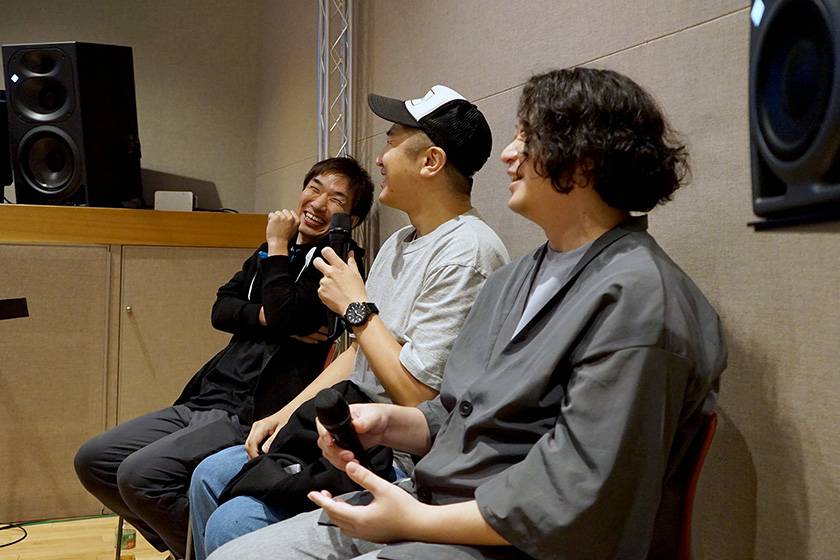
Finally, a Q&A session was held where participants asked various questions. Although this event was a new product launch, it went beyond a simple announcement and served as a valuable opportunity to understand the work of sound effects recording.
Additionally, since it was held in the immersive demo room at Nihon Kogakuin, attendees had the rare chance to experience vivid, immersive sound through the Neumann KH series environment. This experience is likely to change the way people feel when listening to sound in TV shows, games, movies, and more.
The Sennheiser MKH 8000 series, which supports sound in entertainment from behind the scenes, and the MKH 8018, which is considered the culmination of the MKH 8000 series, are poised to become microphones attracting significant attention.
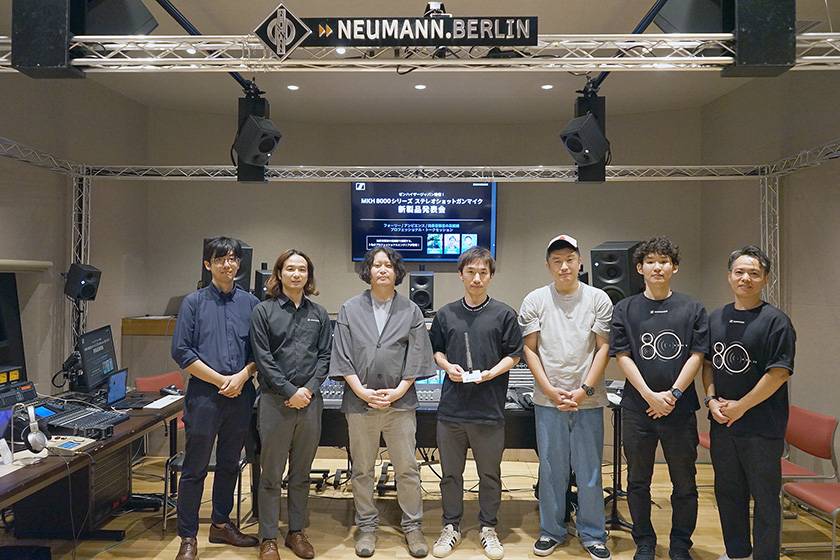
About the MKH 8000 Series
The Sennheiser MKH 8000 Series is a high-end RF condenser microphone lineup designed to handle all kinds of recording environments. Unlike traditional AF condenser microphones, it employs an RF (radio frequency) design, achieving extremely low noise, a wide frequency response, and excellent environmental durability. It operates reliably even under harsh conditions such as high heat and humidity or extreme cold, enabling clear and delicate sound reproduction.
The lineup includes models ranging from omnidirectional to long shotgun and the latest stereo shotgun microphones that offer the directional characteristics and expressive power demanded in professional settings. With natural sound imaging that suppresses off-axis coloration and a symmetrical push-pull transducer design, the MKH 8000 Series is trusted across various fields including video production, field recording, music recording, and broadcasting.
MKH 8000 Series (from Sennheiser’s official website)
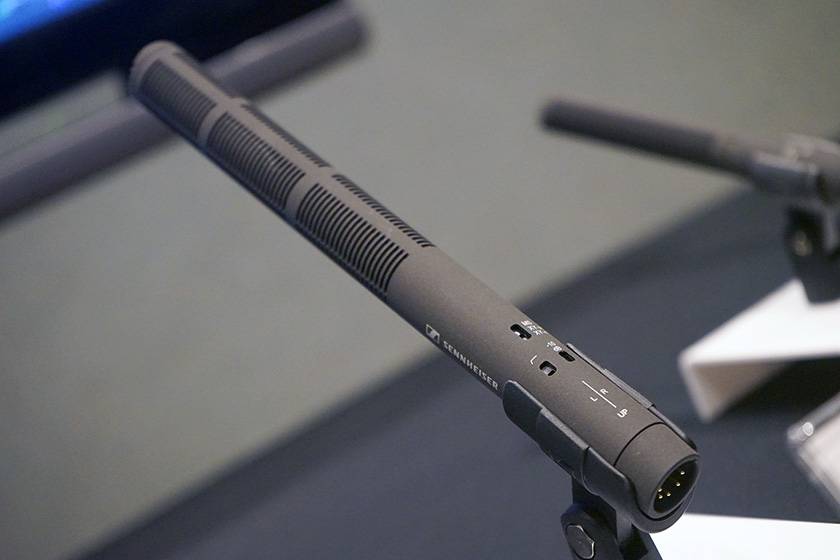
MKH 8018
- MS Capsule Configuration Stereo Shotgun Microphone
- Three Switchable Stereo Modes: MS, XY-Narrow, XY-Wide
- Switchable Low-Cut Filter (-3dB @ 70Hz)
- High-Quality -10dB Pad
- Accurate Sound and Stability Inherited from MKH Technology
- New Aluminum Body, Robust Yet Lightweight at 115g
Exhibited Products
- MKH 8020: Omnidirectional
- MKH 8020: Stereo Set
- MKH 8030: Bidirectional
- MKH 8040: Cardioid (Unidirectional)
- MKH 8040: Stereo Set
- MKH 8050: Hypercardioid (Super-Cardioid)
- MKH 8060: Short Shotgun
- MKH 8070: Long Shotgun
- MKH 8090: Wide Cardioid
- MKH 418 S: MS Shotgun Microphone
- MT 48 U: Audio Interface
- KH 120 II: Monitor Speaker
- KH 150: Monitor Speaker
- KH 750 DSP: Subwoofer





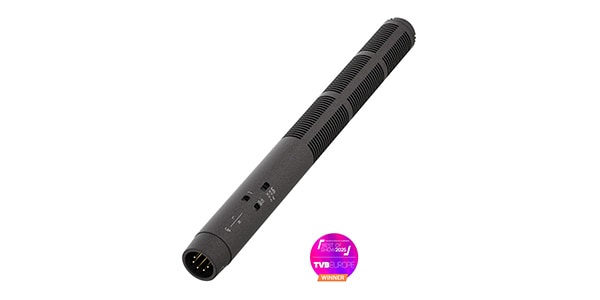


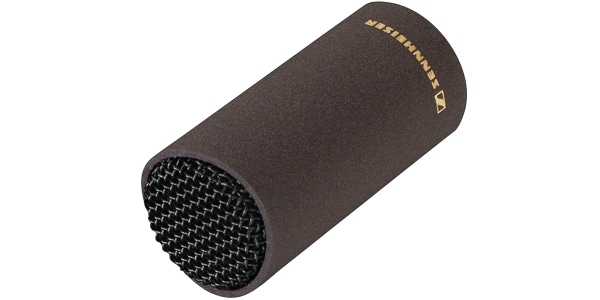
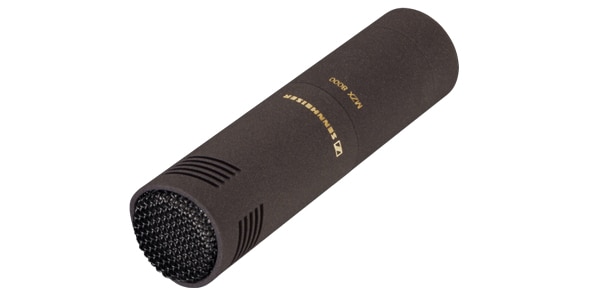

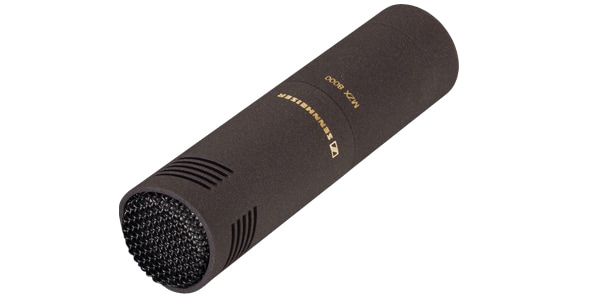

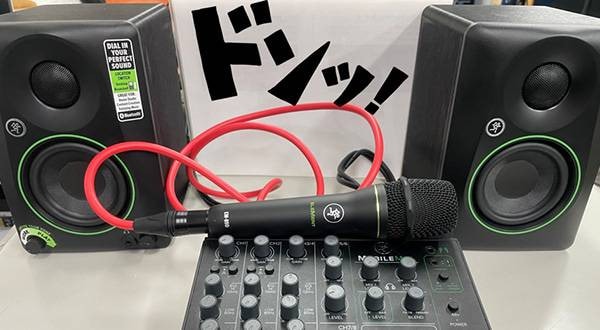
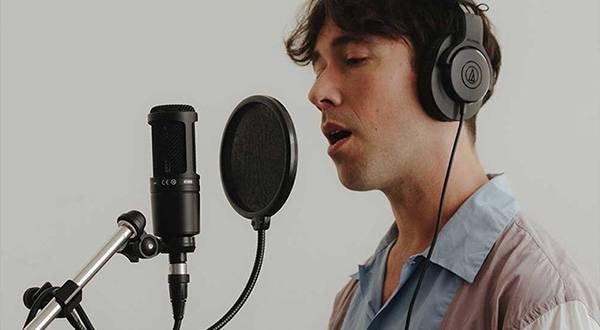
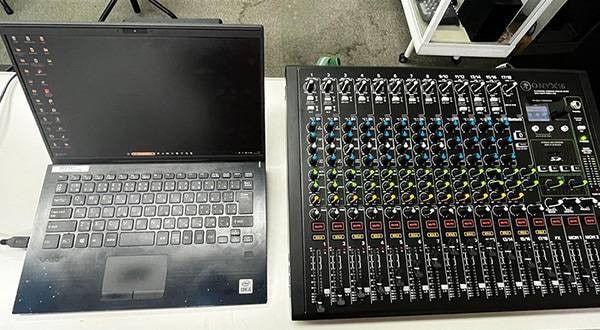


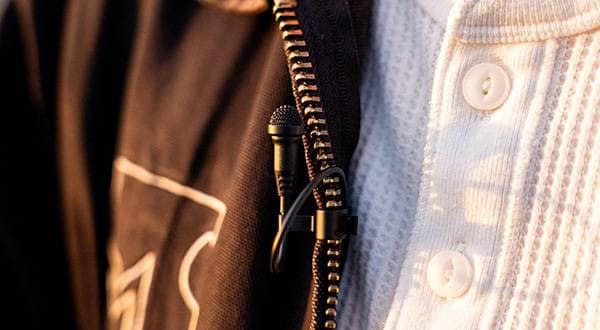


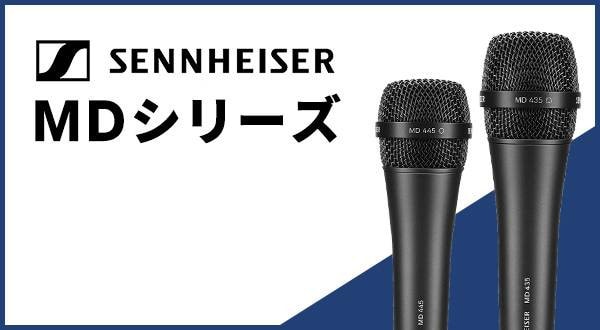
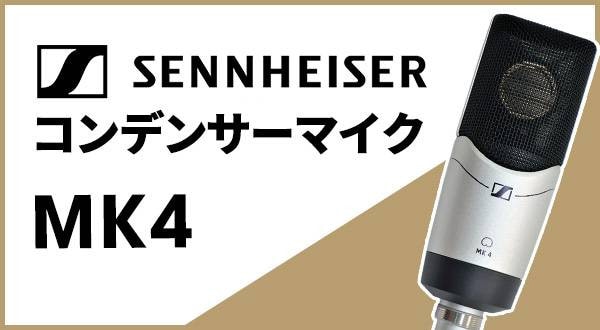
 ゼンハイザー ワイヤレスマイク シリーズ別導入例
ゼンハイザー ワイヤレスマイク シリーズ別導入例
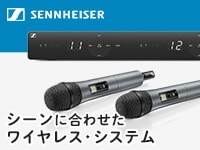 シーンに合わせたワイヤレス・システム
シーンに合わせたワイヤレス・システム
 Sennheiser ボーカルに最適なマイクの選び方
Sennheiser ボーカルに最適なマイクの選び方
 SENNHEISER ワイヤレスマイクの選び方
SENNHEISER ワイヤレスマイクの選び方
 ゼンハイザーワイヤレスマイク比較表
ゼンハイザーワイヤレスマイク比較表
 SENNHEISER(ゼンハイザー)特集
SENNHEISER(ゼンハイザー)特集

